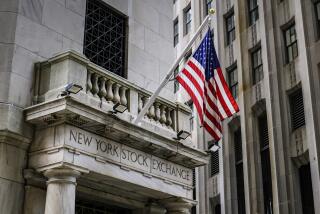Already Wobbly Asia Is Feeling Russia’s Pain
SEOUL — Like a vortex, the global market collapse driven by Moscow’s political and economic tumult last week promises to prolong and deepen the Asian crisis that helped trigger Russia’s woes in the first place.
On the heels of fresh reports showing that Asia’s economic travails have already proved more painful than predicted, analysts warn that the plunge in world markets has unleashed dynamics that will further undermine Japan’s teetering banks and make it even harder for the region’s debt-ravaged countries to raise money.
Events have dampened any remaining hopes of a swift recovery in Asia and raised the prospect of more crises to come.
“I don’t think you can realistically exclude the possibility of a depression [in Asia], although it may be a bit premature to talk about that,” said Richard Samuelson, chief analyst at SBC Warburg Dillon Read Securities in Seoul.
Asia’s misery was on full display last week when somber-faced officials from some of the strongest of the weak--South Korea, Malaysia and Hong Kong--reported sharp second-quarter economic reversals, adding to the Russia-fed panic.
In country after country, the economic scorecard was bleak. For South Korea, it showed a 6.6% quarterly plunge in gross domestic product; in Malaysia, a 6.8% fall; and in Hong Kong, a 5% drop. Even the Philippines, which had insisted that it could escape the negative growth that has also claimed Japan, Singapore and Indonesia, saw its second-quarter GDP shrink 1.2%.
Japan fell even deeper into an economic black hole when the Nikkei stock index crashed below 14,000, an event that left many of Japan’s largest banks unable to meet their international bank capitalization requirements.
That increased the danger that Japan’s banks--which in recent years have accounted for one-third of the lending in the region--will be forced to call in loans from their Asian clients after already shutting off the spigot of new lending.
Indeed, Japan’s once-powerful banks have suffered a dizzying fall from grace. Kenneth Courtis, chief economist for Deutsche Bank’s Asia-Pacific Group, calculates that by the end of Friday’s blood bath in Tokyo, the combined market value of the country’s top 98 banks was less than two-thirds that of Microsoft Corp.
Unless Japan gets its financial house in order--a process that remained bogged down in political wrangling last week--the rest of Asia will stay frozen in place.
“No matter how much Thailand improves, it is still a $115-billion economy,” Courtis said. “Japan is a $4-trillion economy. Until Japan is turned around, the rest of Asia cannot get any better.”
With Japan’s all-important banks forced to the sidelines, last week’s events assumed extra import for the rest of Asia--especially the “IMF economies,” as they are known for having been bailed out by the International Monetary Fund over the past year.
Those nations--South Korea, Indonesia, the Philippines and Thailand--plus Malaysia need between $90 billion and $100 billion just to finance the restructuring of their banking systems, said Irene Cheung, regional economist for Canadian Imperial Bank of Commerce in Singapore. This includes the cost of setting up government institutions to assume the debts of insolvent banks and recapitalize those left standing.
But Russia’s collapse will make it much more expensive for Asian governments to fund this massive financial restructuring, since the cost of borrowing abroad has already soared, according to analysts. That is because foreign lenders have been burned by losses in Russia, Latin America and elsewhere in recent days.
This is particularly painful for the governments of South Korea and Thailand, which have received high marks from the IMF for pressing forward with such politically painful reforms as amending foreign investment laws and closing insolvent banks.
“Korea and Thailand have been making some major changes, but the international hurdle keeps being raised right along with them,” said Stephen Parker, coordinator of economic research for the Asian Development Bank Institute in Tokyo.
*
Even South Korea, where President Kim Dae Jung has been touted as Asia’s most aggressive reformer, would probably find it prohibitively expensive to borrow money abroad today--unlike earlier this year, when it raised badly needed funds by selling $4 billion in government bonds.
Analysts fear that cash-strapped Korean companies, which face similar hikes in the cost of borrowing, will turn to the domestic market to buy hard currency, drawing down the country’s precious foreign reserves. Over time, that could leave this nation’s economy unable once again to pay its international debts--the predicament that led to last year’s $60-billion emergency bailout by the IMF.
In this risk-averse climate, Asian countries have few options but to ratchet up their exports and pump even more low-priced products into an already glutted world, accelerating a deflationary spiral that has pushed commodity prices to decade lows.
Even the most optimistic economists have pushed back their predictions for an Asian turnaround to late next year in economies such as South Korea and Hong Kong and to as much as five years in Indonesia.
And this heightens the threat of social unrest, with tens of millions of Asians entering the ranks of the unemployed at a time when prices are rising and opportunities fast evaporating.
Already in Indonesia, where half the country’s 200 million people are expected to fall below the poverty level by the end of the year, there have been fresh reports in recent days of violence and looting aimed at the ethnic Chinese who dominate the country’s business sector.
In South Korea, the official jobless rate hit a 31-year high of 7.6% in July. By year’s end, more than 2 million people are expected to be out of work.
Frustration over the ravaging effects of the free markets, meanwhile, has even extended to Hong Kong, long the region’s capitalist epicenter, which last week found itself frantically buying stocks to halt a slide in prices and “punish” currency traders the government blames for many of its problems.
Even Hong Kong’s most ardent cheerleaders now find themselves at a loss to defend what they view as an irreparable erosion of the territory’s credibility among investors, who worry that they could be the next victims of the government’s wrath.
“My fear is a great deal of damage has been done to Hong Kong’s reputation as an international marketplace,” said Richard Margolis, first vice president of equity research at Merrill Lynch Asia Pacific Ltd. in Hong Kong.
Margolis said the Hong Kong government’s actions have simply postponed the day of reckoning for an inflated stock market that does not reflect the realities of an economy in a full-blown recession.
*
“I think it [a market correction] still has to happen, and the effect of the government intervention has been to make the final restructuring more sudden, unpredictable and far more damaging than before,” Margolis said.
This bodes ill for Asia’s strongest economy--China--which has escaped the worst of the global turmoil because of its relatively isolated economy and currency. But China is heavily invested in Hong Kong and depends on its stock market to raise capital.
China’s Communist leaders are now preoccupied with their struggle to maintain a GDP growth rate of at least 6% to 7% so they can provide jobs for the millions of people displaced by the government’s program to overhaul debt-laden banks and state-owned enterprises.
Meanwhile, the rest of Asia is watching China for signs that its public commitment to maintaining the value of its currency, the yuan, might be wavering under pressure from Chinese firms hurt by competition from countries with devalued currencies.
Plague-like, nature is also a worry for Asia. China’s uncertainty has been worsened by devastating floods this summer that have caused $24 billion in damage. Torrential rainstorms have also wreaked havoc in South Korea and Japan, while an extended drought in the Philippines cut agricultural output by 7.5% during the first half of the year.
More to Read
Sign up for Essential California
The most important California stories and recommendations in your inbox every morning.
You may occasionally receive promotional content from the Los Angeles Times.










